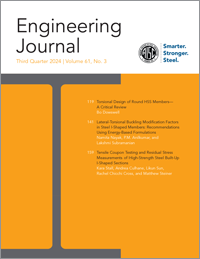Tensile Coupon Testing and Residual Stress Measurements of High-Strength Steel Built-Up I-Shaped Sections
DOI:
https://doi.org/10.62913/engj.v61i3.1326Keywords:
high strength structural steel, mechanical properties, residual stress, built-up sectionsAbstract
High strength structural steels (with yield stresses greater than 65 ksi) may have notably different material characteristics when compared to structural steels conventionally used in building construction [i.e., ASTM A992/A992M (2022) or A572/A572M Gr. 50 (2021)]. This paper presents findings from an experimental program that investigated the material characterization of ASTM A656/A656M Gr. 80 (2024) plate steel. The results obtained were compared to conventional ASTM A572/A572M Gr. 50 steel. Two types of testing were performed for this work: tensile coupon testing and residual stress testing. The tensile coupon testing was carried out for both the A656/A656M Gr. 80 and A572/A572M Gr. 50 plate material. The A656/A656M Gr. 80 plate material showed more variation between the two different plate thicknesses in both mechanical behavior and microstructure due to differences in steel production. The 0.375 in. thick plate exhibited a clear yield plateau with an ultimate/yield stress ratio similar to the Gr. 50 material. In contrast, the 0.5 in. plate did not have a yield plateau and reached lower ultimate strain. The residual stress testing was performed using a sectioning technique for one A572/A572M Gr. 50 and five A656/A656M Gr. 80 built-up sections that were fabricated from 0.5 in. and 0.375 in. plate material. Residual stresses obtained from measurements were compared to previously published predictive models. The ECCS model and BSK99 models were found to be reasonable predictors of residual stresses for all specimens except the one section fabricated from 0.5 in. thick Gr. 80 plate. When comparing the Gr. 50 and Gr. 80 specimens of the same cross-sectional geometry, the residual stresses were similar, implying that cross-sectional geometry is more prevalent than the nominal yield stress in determining residual stresses in built-up I-sections.

